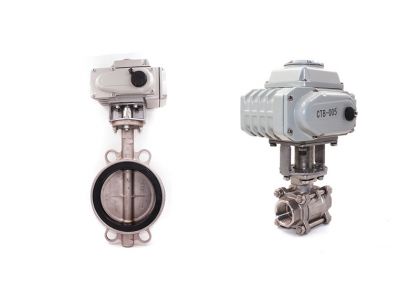
Motorized ball valves and motorized butterfly valves are the two most common types of motorized valves, yet they exhibit significant differences in structure, application, and performance.
This article will explain the distinctions between these two motorized valves from multiple perspectives.
Key Differences
Motorized Ball Valve: The valve core is a perforated sphere. Rotating the ball valve 90 degrees opens or closes the valve. Electrically actuated ball valves feature excellent sealing performance and low flow resistance, but are typically available in smaller diameters.
Motorized Butterfly Valve: The valve core resembles a disc. Rotating the valve plate 90 degrees regulates flow. Electrically actuated butterfly valves feature compact structure, low cost, light weight, and the ability to accommodate large diameters. However, their sealing performance is relatively poor.
Detailed Feature Comparison
Motorized Ball Valve
Flow Capacity: With minimal flow resistance, full-bore ball valves offer greater flow capacity than reduced-bore valves. The passage of a full-bore ball valve matches the pipe diameter, resulting in virtually no pressure loss.
Sealing Performance: The ball valve exhibits exceptional sealing performance, featuring high pressure between the seat and ball valve, making it suitable for applications requiring zero leakage.
Working Pressure: High pressure resistance, suitable for high-pressure applications. PN16-PN420
Torque: The operating torque required for motorized ball valves is high, with significant torque during opening and closing, but lower torque during the process.
Pipe diameter: Available in a wide range of diameters, but large-diameter motorized ball valves are costly. Common motorized ball valve diameters do not exceed DN200.
Procurement Cost: The complex structure and substantial weight of motorized ball valves result in higher procurement costs.
Motorized Butterfly Valve
Flow Capacity: High flow resistance. The valve disc resides within the pipeline, creating some resistance even when fully open.
Sealing Performance: Motorized butterfly valves offer good sealing performance but are inferior to ball valves. Under high working pressure or after wear, the risk of leakage is higher than with ball valves.
Working Pressure: Low pressure tolerance, typically used in medium-to-low pressure applications (PN10-PN16).
Torque: Requires low operating torque, placing minimal demands on actuator specifications.
Pipe Diameter: Suitable for large-diameter pipelines with a compact structure. Large-diameter butterfly valves offer lower costs than ball valves. Common sizes range from DN50 to DN600.
Procurement Cost: Features a compact design, lightweight construction, and low overall cost.
Should I choose a motorized ball valve or a motorized butterfly valve?
1. Sealing Requirements
For zero-leakage, high-sealing applications, prioritize electric ball valves.
For applications permitting slight leakage, electric butterfly valves are sufficient.
2. Working Pressure Rating
For PN25 and above, electric ball valves are the preferred choice.
For PN16, note that electric butterfly valves offer lower costs.
3. Pipe Diameter
For small diameters below DN200, ball valves offer superior sealing performance. If budget permits, ball valves are recommended.
For large diameters above DN200, butterfly valves are preferred due to their lower cost.
4. Medium Characteristics
For pure media free of impurities, either ball valves or butterfly valves are suitable.
For media containing impurities such as suspended particles, ball valves are prone to wear and sticking. In such cases, butterfly valves with specific designs are preferable.
I hope this article helps you fully understand the differences between motorized ball valves and motorized butterfly valves.